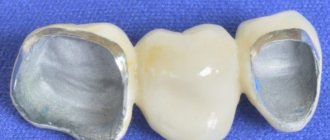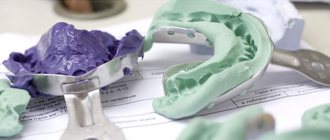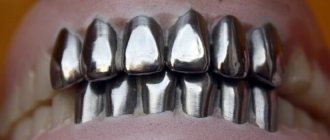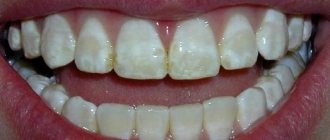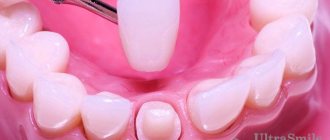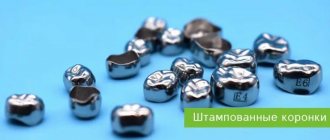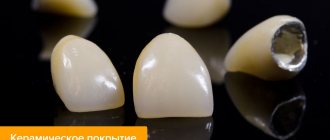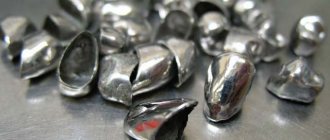High-quality complete dental prosthetics with crowns in Moscow implies not only the restoration of their chewing function. Teeth are the most important component of a beautiful, attractive smile that evokes the sympathy and trust of others. Therefore, both affordable metal-ceramic crowns and more expensive aesthetic crowns should fit perfectly into the dentition and serve for a long time without causing undesirable consequences. Modern medicine has all the materials and technologies necessary for this.
Filling or crown: which option to choose?
The crown of a tooth refers to both its part located above the gum mucosa and an artificial structure in the form of a case, put on the natural crown destroyed by caries. The need for such tooth restoration arises after treatment of deep caries and pulpitis with the passage of root canals, and sometimes after mechanical trauma to the jaw and tooth.
Many patients are afraid of having a crown installed and beg the dentist to limit themselves to a filling. But if you fill a pulpless tooth, of which less than 50% of its own tissue remains, then it will most likely have to be removed very soon. After all, hard tissues after removing the pulp become very fragile and easily crack under load. Prosthetics after removal will become inevitable, but will cost much more.
Indications and contraindications
Installation of combined products is indicated in the following cases:
- the crown part of the tooth is severely damaged and cannot be restored by other methods (approximately two-thirds of the tissue must be removed);
- increased abrasion, the lower third of the face is characterized by a decrease in height, that is, the normal contours are distorted;
- the color of the enamel has been changed, the process is irreversible and other restoration options will not be effective;
- mobility of individual units of the row is observed (such crowns are used as splinting, strengthening devices);
- partial edentia, in which the use of bridge structures is recommended;
- for implantation;
- as a reliable support for fixing orthodontic appliances;
- when replacing old dentures that are damaged or worn out.
Combined products are not installed in the following situations:
- the wall of a natural tooth is thinned, weakened and will not withstand additional load;
- risks of serious pulp damage during turning;
- the need to restore lower anterior teeth;
- deep bite, accompanied by protrusion of the upper incisors;
- age restrictions (such systems are not used until 16-18 years old);
- bruxism.
Why do they grind down a tooth for a crown?
The dentist must remove part of the tissue to form a stump of a certain shape:
- a ledge is formed at the edge of the gum, on which the crown will be placed in the future;
- The edges of the tooth should remain almost parallel, and not cone towards the chewing edge.
The service life of the artificial crown largely depends on the quality of preparation and compliance with these two conditions. If there is no smooth and even ledge, its edge will not adhere to the tooth, but will hang over the gum, forming a gap. Soft plaque will accumulate around, and colonies of pathogenic microflora developing in it will cause caries and gum inflammation.
If the tooth stump takes a cone-shaped shape after filing, it will be difficult for the dental technician to produce a functional structure that can withstand the chewing load. This is fraught with depressurization (or decementing) of the crown. Residues of food and soft plaque with microflora will penetrate under it, which will eventually lead to its loss.
Preparation for the crown of a living, non-pulpless tooth should be carried out with plenty of cooling. After all, overheating of the tissues will cause inflammation of the pulp, which may appear after the installation of the crown. Due to the need to treat pulpitis, it will have to be removed and redone after treatment of the canals.
All the pros and cons
Combined crowns are an economical solution to the problem of functionality and aesthetics of the dentition. Expensive metal-free structures made of zirconium oxide can ensure the strength and attractiveness of teeth.
All-ceramic products are installed on the frontal zone. Due to their low strength, such dentures are not suitable for fixation on chewing elements. The cost of this model is higher than that of the combined ones.
Varieties
The market offers three types of microprostheses: metal-composite, metal-ceramic and metal-plastic. The base production technology is the same. The difference lies in the cladding.
Metal-plastic
Metal microprostheses with an outer layer of polymethacrylate. Cladding material is available in different forms. Various technologies for applying external coating are used.
Plastic does not enter into a chemical bond with metal. Special liquids can increase the adhesion force. This eliminates the need for retention.
Production technology:
- After the casting or stamping procedure is completed, the frame is sandblasted and degreased.
- Modeling a plastic crown with wax on a plaster model of the unit, made from an impression.
- Packing the model into molding mass, removing wax during heating.
- Filling the cavity with plastic under pressure.
It is possible to use other methods of applying the composition. For example, layer-by-layer application of a polymer composition with a brush (spatula). Each layer is polymerized.
The technology for applying the composition is determined by the original form. Polymer coating is supplied in powder and liquid form. The components are mixed immediately before use in certain proportions.
According to the curing method, the material can be cold or hot polymerization.
Metal-ceramic
The cladding is glass ceramics. The starting material is ceramic powder diluted in liquid. The material is applied layer by layer with each layer being fired in an oven. After processing, the product is fitted to the tooth, refined and glazed.
Durable microprostheses are suitable for installation in the chewing and frontal areas. They are distinguished by aesthetics, functionality and durability. Disadvantage - the thickness of the crown in some places reaches 2 mm.
Metal composite
Composite mass is a hybrid composition consisting of organic resins and tiny ceramic particles. The composition is applied to the base and polymerized with a lamp. The pros and cons of a composite are determined by the specific material. The products are inferior in quality to ceramic structures. It is possible to repair metal-composite dentures in the patient’s mouth if there are clinical indications.
Step-by-step installation algorithm
Manufacturing and fastening of a metal-ceramic structure with a solid base includes the following steps:
- Inspection and diagnostics.
- Product selection.
- Turning of the support element.
- Production of microprosthesis.
- Making impressions and casting the frame.
- Fitting the base to the unit.
- Determining the shade of artificial enamel.
- Sintering of the ceramic layer.
- Fitting, correction.
- Glazing, final processing.
- Fastening to the element using cement.
How to take impressions correctly?
If the mucous membrane was damaged when grinding the native crown, the procedure for taking impressions should be postponed until it is restored.
- In some patients, the injured gum can give recession - move away from the neck of the tooth and expose its root.
- Due to the presence of blood, the materials used to obtain impressions may not clearly depict the formed ledge.
As a result, the edge of the manufactured and installed crown will stick out above the gum, which will significantly reduce the aesthetics of prosthetic treatment of the front teeth.
Advantages and disadvantages
Combined models are an economical solution for row restoration. They retain functionality, provide the aesthetics of the range, and are relatively inexpensive. Various materials are used for manufacturing; the best solutions are ceramics and metal-free ones using zirconium oxide. Installation is simple, quick, and the service life of such crowns is up to fifteen years. In this case, the tooth is preserved; only turning is needed for installation. There are not many disadvantages, they depend on the materials used.
Is it possible or not?
Combined type crowns are placed on any teeth. Most often on those located in the smile zone - frontal maxillary, upper premolars. If the client wishes, it is possible to cover the molars, but it will not be advisable to sharpen the supporting teeth too much.
It is recommended to install combined speakers in the following cases:
- destruction of more than 70% of the tooth volume;
- decreased height of the lower part of the face due to tooth wear;
- irreversible change in enamel shade;
- severe tooth mobility;
- complete or partial absence of teeth for various reasons;
- implantation;
- replacing old crowns;
- placing medications in the tooth;
- production of supports for special devices.
Porcelain crowns for front teeth
The main distinctive feature of porcelain crowns is that they do not contain metal impurities, so their use is especially justified if the patient is allergic to metal. Materials for porcelain crowns are special porcelain-based mixtures that are inert and therefore do not stain or irritate soft tissue.
Just a few years ago, in most cases, prosthetics with porcelain crowns were carried out in the anterior part of the jaw, since it was believed that such products were too fragile for chewing teeth, which bear heavy loads. Indeed, conventional porcelain crowns are more fragile compared to their metal counterparts, but the use of a zirconium dioxide frame made it possible to achieve the necessary strength and make it possible to use them in any area of the jaw. In general, the indications for use of porcelain crowns are almost the same as for other structures of a similar type.
Making porcelain crowns
The production of porcelain crowns requires the presence of expensive equipment and experienced specialists on the staff of a clinic or dental laboratory. Today, two methods are used to produce such crowns - layer-by-layer application of porcelain mass and injection molding technology. The second method is considered more modern (as it provides the finished structure with greater strength) and is used in most dental laboratories. The production of a porcelain crown takes place in several stages.
Stage 1 - preparatory
Preparation of teeth for a porcelain crown and selection of color for the future prosthesis.
Stage 2 - taking an impression
The doctor takes impressions of the teeth, which are then sent to a dental laboratory.
Stage 3 - matrix production
Thin platinum foil is used as a mold for the future dental crown, which is placed on the model and filled with porcelain mass.
Stage 4 - firing
The crown goes through several stages of processing under the influence of high temperatures.
Stage 5 - product processing
The dental technician makes adjustments to the structure so that its shape and surface perfectly match the patient’s teeth. At the final stage, the finished structure is painted and glazed.
Price for porcelain crowns in Moscow
The price of a porcelain crown per tooth in Moscow dentistry largely depends on the level of the clinic where the patient is being treated. In most cases, such a design is offered in dentistry at the “business” or “premium” level, where much attention is paid to the aesthetic side of prosthetics. At the same time, the price of porcelain crowns for the front teeth is practically no different from similar designs for chewing teeth.
| Type of dental crown | Price |
| Ceramic porcelain crown | 13,000 - 17,000 rubles |
| Porcelain crown on a zirconium dioxide frame | 19,000 - 25,000 rubles |
Porcelain or metal-ceramic crowns?
Much more often we have to compare porcelain and metal-ceramic crowns. Structures with a metal frame have a number of advantages: they are stronger and significantly cheaper. At the same time, they lose greatly in aesthetics: all competent specialists will recommend putting porcelain crowns on your front teeth if you want your smile to be as natural as possible. It is believed that it is justified to install metal-ceramic crowns on chewing teeth, and porcelain crowns on incisors. However, if a porcelain crown has a zirconium dioxide frame, then it can be used to restore any tooth.
Signs of high-quality preparation for metal-ceramics
The result of correct preparation for a stamped or cast crown must meet the following criteria:
To get detailed advice on treatment, preparation and prosthetics of teeth, sign up for a consultation at Aristocrat-Dent dentistry.
You can make an appointment by calling 8 (495) 638-05-05. Consultation is free if treatment is started on the day of treatment.
